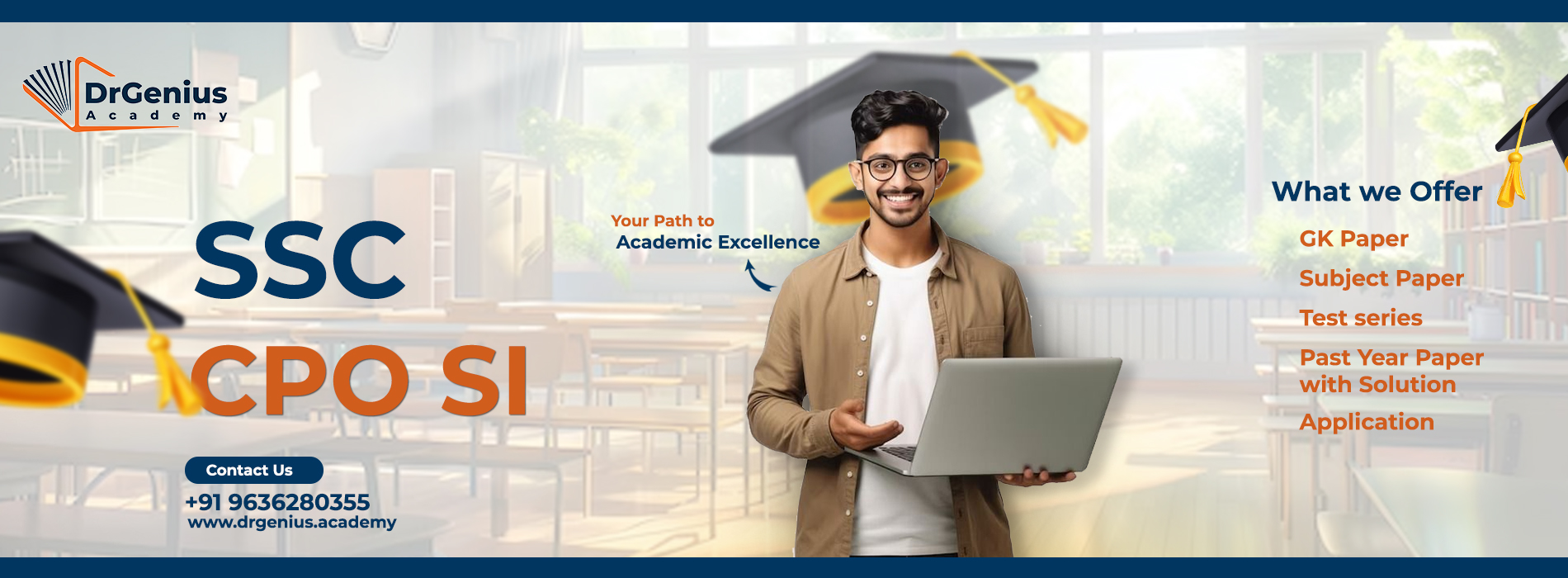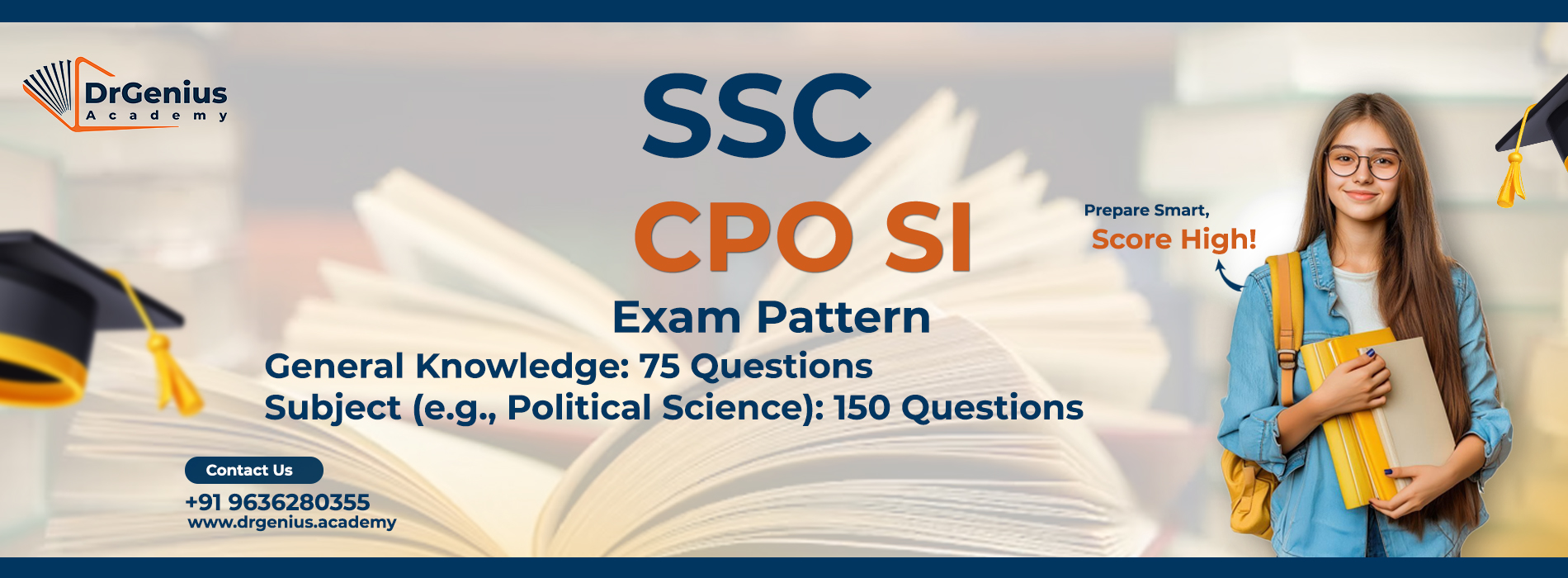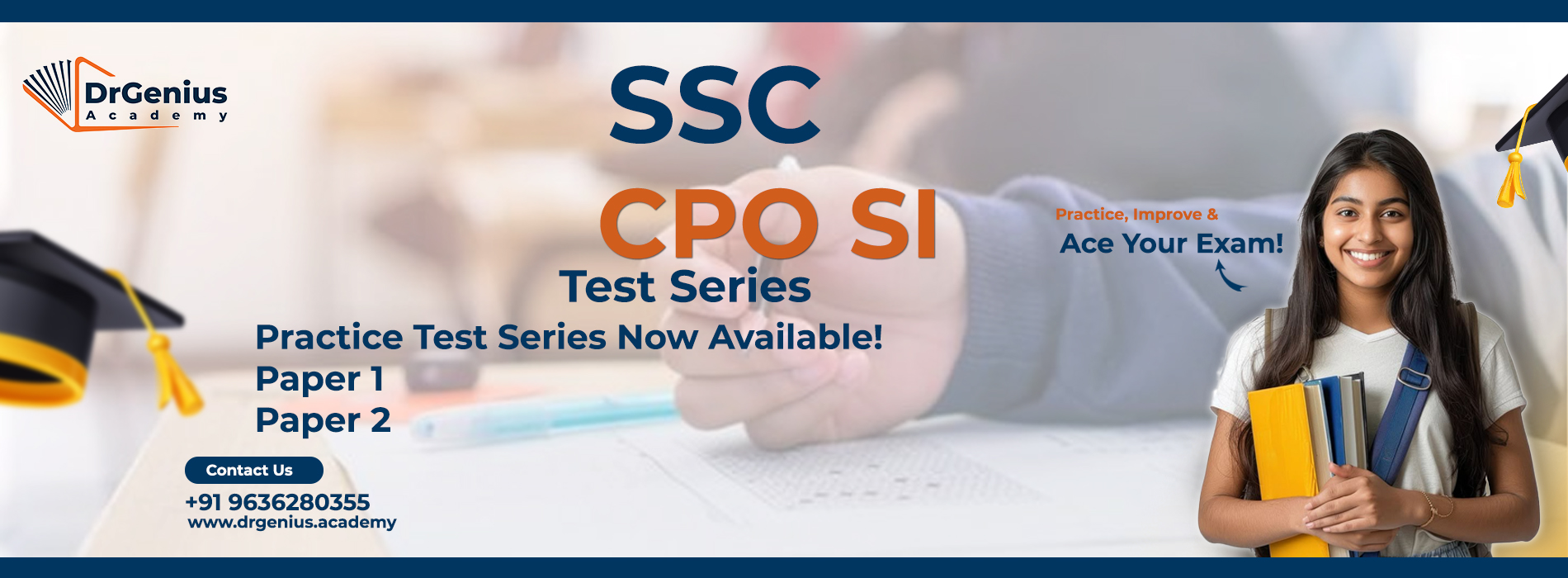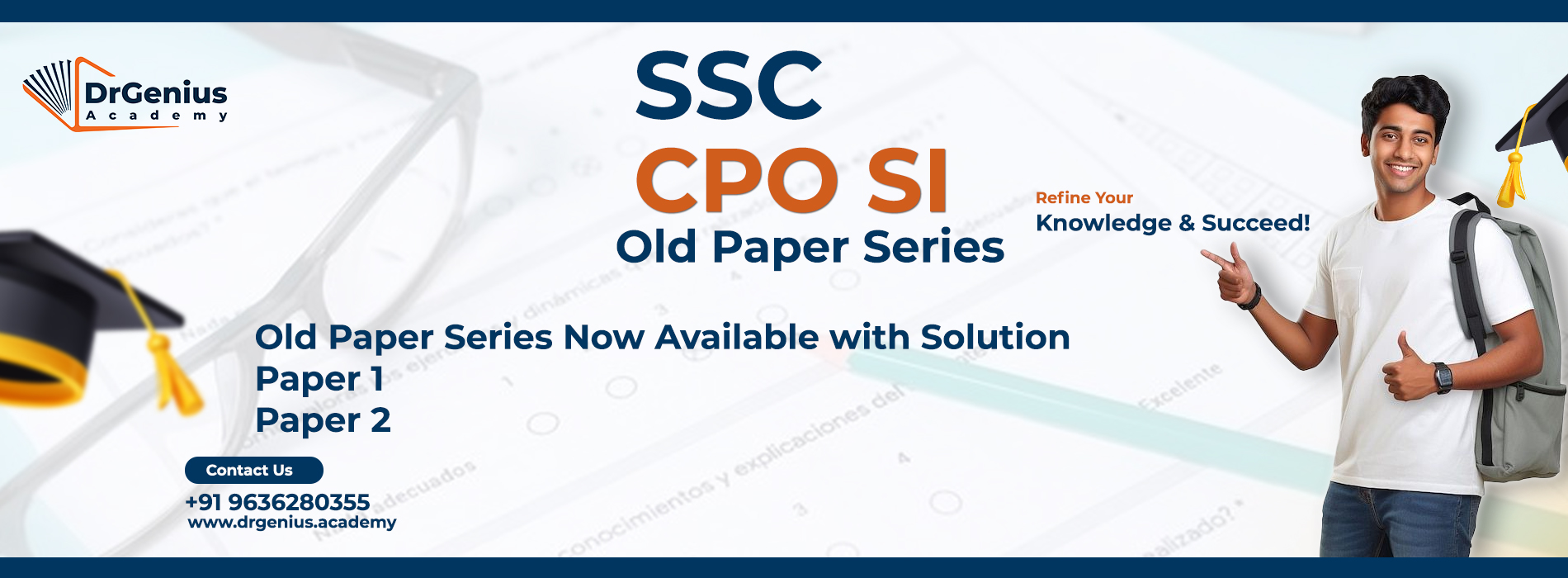SSC CPO SI 2025 Exam Online Preparation – Study Materials & Coaching




SSC CPO SI
- Notification
- Schems (Pattern)
- Topic
- Syllabus
- Old Paper
- Faculties
- Course
- Test Series
- Fees Structure
- Admit Card
- Instruction For Candidates
- Answer Key
- Cut Off marks
- Result
PATTERN FOR EXAM
Scheme of the Examination:
• The examination will consist of Paper-I, Physical Standard Test (PST)/Physical Endurance Test (PET), Paper-II and Detailed Medical Examination (DME). All these stages of the examination are mandatory.
Scheme of Paper-I:
| Part | Subject | Number of Questions | Maximum Marks | Time Duration |
|---|---|---|---|---|
| I | General Intelligence and Reasoning | 50 | 50 | 2 Hours |
| II | General Knowledge and General Awareness | 50 | 50 | |
| III | Quantitative Aptitude | 50 | 50 | |
| IV | English Comprehension | 50 | 50 |
Scheme of Paper-II:
| Subject | Number of Questions | Maximum Marks | Time Duration |
|---|---|---|---|
| English Language & Comprehension | 200 | 200 | 2 Hours |
• Questions in both papers will be of Objective Multiple Choice Type. Questions will be set in Hindi and English in Parts-I, II and III of Paper-I. There will be negative marking of 0.25 marks for each wrong answer in Paper-I & Paper-II.
• Marks scored by candidates in Computer Based Examination will be normalized and such normalized scores will be used to determine final merit and cut off marks.
• National Cadet Corps (NCC) certificate holders (as on 01.08.2024) will be given bonus marks in Paper-I and Paper-II which will be added to the normalized scores of such candidates.
| S.No. | Type of NCC Certificate | Bonus Marks in each Paper (Paper-I and Paper-II) |
|---|---|---|
| 1 | NCC ‘C’ Certificate | 10 marks (5% of the maximum marks) |
| 2 | NCC ‘B’ Certificate | 6 marks (3% of the maximum marks) |
| 3 | NCC ‘A’ Certificate | 4 marks (2% of the maximum marks) |
• In case of any difference/discrepancy/dispute in the Questions between English and Hindi, the content of English version shall prevail.
SYLLABUS
Indicative syllabus for Computer Based Examination:
Paper-I:
General Intelligence and Reasoning:
It would include questions of both verbal and non-verbal type. This component may include questions on analogies, similarities and differences, space visualization, spatial orientation, problem solving, analysis, judgment, decision making, visual memory, discrimination, observation, relationship concepts, arithmetical reasoning and figural classification, arithmetic number series, non-verbal series, coding and decoding, statement conclusion, syllogistic reasoning etc. The topics are, Semantic Analogy, Symbolic/Number Analogy, Figural Analogy, Semantic Classification, Symbolic/ Number Classification, Figural Classification, Semantic Series, Number Series, Figural Series, Problem Solving, Word Building, Coding & de-coding, Numerical Operations, symbolic Operations, Trends, Space Orientation, Space Visualization, Venn Diagrams, Drawing inferences, Punched hole/ pattern-folding & un-folding, Figural Pattern- folding and completion, Indexing, Address matching, Date & city matching Classification of centre codes/ roll numbers, Small & Capital letters/ numbers coding, decoding and classification, Embedded Figures, Critical thinking, Emotional Intelligence, Social Intelligence, etc.
SYLLABUS
कंप्यूटर आधारित परीक्षा के लिए सांकेतिक पाठ्यक्रम:
पेपर-I:
सामान्य बुद्धि और तर्क:
इसमें मौखिक और गैर-मौखिक दोनों प्रकार के प्रश्न शामिल होंगे। इस घटक में सादृश्य, समानताएं और अंतर, स्थान दृश्य, स्थानिक अभिविन्यास, समस्या समाधान, विश्लेषण, निर्णय, निर्णय लेने, दृश्य स्मृति, भेदभाव, अवलोकन, संबंध अवधारणाएं, अंकगणितीय तर्क और आकृति वर्गीकरण, अंकगणितीय संख्या श्रृंखला, गैर-मौखिक श्रृंखला, कोडिंग और डिकोडिंग, कथन निष्कर्ष, न्याय तर्क आदि पर प्रश्न शामिल हो सकते हैं। विषय हैं, अर्थगत सादृश्य, प्रतीकात्मक / संख्या सादृश्य, आकृति सादृश्य, अर्थगत वर्गीकरण, प्रतीकात्मक / संख्या वर्गीकरण, आकृति वर्गीकरण, अर्थगत श्रृंखला, संख्या श्रृंखला, आकृति श्रृंखला, समस्या समाधान, शब्द निर्माण, कोडिंग और डी-कोडिंग, संख्यात्मक संचालन, प्रतीकात्मक संचालन, रुझान, स्थान अभिविन्यास, स्थान दृश्य, वेन आरेख, निष्कर्ष निकालना, छिद्रित छेद / पैटर्न-फोल्डिंग और अन-फोल्डिंग, आकृति पैटर्न-फोल्डिंग और पूर्णता, अंतर्निहित आंकड़े, आलोचनात्मक सोच, भावनात्मक बुद्धिमत्ता, सामाजिक बुद्धिमत्ता, आदि।
General Knowledge and General Awareness:
Questions in this component will be aimed at testing the candidates’ general awareness of the environment around him and its application to society. Questions will also be designed to test knowledge of current events and of such matters of every day observations and experience in their scientific aspect as may be expected of any educated person. The test will also include questions relating to India and its neighboring countries especially pertaining to History, Culture, Geography, Economic Scene, General Polity, Indian Constitution, Scientific Research, etc.
सामान्य ज्ञान और सामान्य जागरूकता:
इस घटक में पूछे जाने वाले प्रश्न उम्मीदवारों की अपने आस-पास के वातावरण और समाज में इसके अनुप्रयोग के बारे में सामान्य जागरूकता का परीक्षण करने के उद्देश्य से होंगे। प्रश्न वर्तमान घटनाओं और हर दिन के अवलोकन और अनुभव के ऐसे मामलों के वैज्ञानिक पहलू के ज्ञान का परीक्षण करने के लिए भी डिज़ाइन किए जाएंगे, जैसा कि किसी भी शिक्षित व्यक्ति से अपेक्षित हो सकता है। परीक्षण में भारत और उसके पड़ोसी देशों से संबंधित प्रश्न भी शामिल होंगे, विशेष रूप से इतिहास, संस्कृति, भूगोल, आर्थिक परिदृश्य, सामान्य राजनीति, भारतीय संविधान, वैज्ञानिक अनुसंधान आदि से संबंधित।
Quantitative Aptitude:
The questions will be designed to test the ability of appropriate use of numbers and number sense of the candidate. The scope of the test will be computation of whole numbers, decimals, fractions and relationships between numbers, Percentage, Ratio and Proportion, Square roots, Averages, Interest, Profit & Loss, Discount, Partnership Business, Mixture and Alligation, Time and distance, Time & work, Basic algebraic identities of School Algebra and Elementary surds, Graphs of Linear Equations, Triangle and its various kinds of centres, Congruence and similarity of triangles, Circle and its chords, tangents, angles subtended by chords of a circle, common tangents to two or more circles, Triangle, Quadrilaterals, Regular Polygons, Circle, Right Prism, Right Circular Cone, Right Circular Cylinder, Sphere, Hemispheres, Rectangular Parallelepiped, Regular Right Pyramid with triangular or square base, Trigonometric ratio, Degree and Radian Measures, Standard Identities, Complementary angles, Heights and Distances, Histogram, Frequency polygon, Bar diagram & Pie chart.
मात्रात्मक योग्यता :
प्रश्न उम्मीदवारों की संख्याओं के उचित उपयोग और संख्या बोध की क्षमता का परीक्षण करने के लिए डिज़ाइन किए जाएंगे। परीक्षण का दायरा पूर्ण संख्याओं, दशमलव, अंशों और संख्याओं के बीच संबंधों, प्रतिशत, अनुपात और समानुपात, वर्गमूल, औसत, ब्याज, लाभ और हानि, छूट, साझेदारी व्यवसाय, मिश्रण और मिश्रण, समय और दूरी, समय और कार्य, स्कूल बीजगणित और प्रारंभिक करणी की मूल बीजीय पहचान, रैखिक समीकरणों के ग्राफ, त्रिभुज और इसके विभिन्न प्रकार के केंद्र, त्रिभुजों की सर्वांगसमता और समानता, वृत्त और इसकी जीवाएं, स्पर्श रेखाएं, वृत्त की जीवाओं द्वारा बनाए गए कोण, दो या दो से अधिक वृत्तों की सामान्य स्पर्श रेखाएं, त्रिभुज, चतुर्भुज, नियमित बहुभुज, वृत्त, लम्ब प्रिज्म, लम्ब वृत्तीय शंकु, लम्ब वृत्तीय बेलन, गोला, गोलार्ध, आयताकार समांतर चतुर्भुज, त्रिकोणीय या वर्गाकार आधार वाला नियमित लम्ब पिरामिड, त्रिकोणमितीय अनुपात, डिग्री और रेडियन माप, मानक पहचान, पूरक कोण, ऊँचाई और दूरियाँ, हिस्टोग्राम, आवृत्ति बहुभुज, बार आरेख और पाई चार्ट।
English Comprehension:
Candidates’ ability to understand correct English, his/ her basic comprehension and writing ability, etc. would be tested.
अंग्रेजी समझ:
उम्मीदवारों की सही अंग्रेजी समझने की क्षमता, उनकी बुनियादी समझ और लेखन क्षमता आदि का परीक्षण किया जाएगा।
Paper-II
English Language and Comprehension :
Questions in these components will be designed to test the candidate’s understanding and knowledge of English Language and will be based on error recognition, filling in the blanks (using verbs, preposition, articles, etc.), Vocabulary, Spellings, Grammar, Sentence Structure, Synonyms, Antonyms, Sentence Completion, Phrases and Idiomatic use of words, comprehension, etc.
पेपर-II
अंग्रेजी भाषा और समझ :
इन घटकों में प्रश्न उम्मीदवार की अंग्रेजी भाषा की समझ और ज्ञान का परीक्षण करने के लिए डिज़ाइन किए जाएंगे और त्रुटि पहचान, रिक्त स्थान भरने (क्रिया, पूर्वसर्ग, लेख आदि का उपयोग करके), शब्दावली, वर्तनी, व्याकरण, वाक्य संरचना, समानार्थी शब्द, विलोम, वाक्य पूर्णता, वाक्यांश और शब्दों का मुहावरेदार उपयोग, समझ आदि पर आधारित होंगे।
INSTRUCTION FOR CANDIDATES
- Sub-Inspector (GD) in CAPFs : Group ‘B’ (Non-Gazetted), Non-Ministerial.
- Sub-Inspector (Executive) - (Male/Female) in Delhi Police : Group ‘C’
EDUCATION QUALIFICATION :
- Bachelor’s degree from a recognized university or equivalent.
AGE
- Min : 20 Years
- Max : 25 Years
Note : Permissible relaxation in upper age limit for different categories, excluding the departmental candidates of Delhi Police
EYE SIGHT :
The minimum near vision should be N6 (better eye) and N9 (worse eye). The minimum distant vision should be 6/6 (better eye) and 6/9 (worse eye) of both eyes without any correction like wearing glasses or surgery of any kind to improve visual acuity. In right handed person, the right eye is better eye and vice versa.
NOTE : Finally selected candidates for the posts of Sub-Inspector would, as part of training curriculum, have to pass seven obstacle events as mentioned below, failing which they may not be retained in the Force:- Jumping over the Vertical Board.
- Holding the rope on jumping from the Board.
- Tarzan Swing
- Jumping on the Horizontal Board
- Parallel Rope
- Monkey Crawl
- Vertical Rope
MODE OF SELECTION:
-
Minimum qualifying marks in Paper-I and Paper-II (without adding bonus marks applicable to NCC
certificate
holders) are as follows :
- UR: 30%
- OBC / EWS: 25%
- All other categories: 20%
- On the basis of their performance in Paper-I (including bonus marks in case of NCC certificate), candidates will be shortlisted for appearing in PST/PET Examination.
- PST/PET are mandatory but qualifying in nature.
- Only those candidates who qualify in PST/PET will be allowed to appear in Paper-II Examination.
- On the basis of their performance in Paper-I and Paper-II (including bonus marks in case of NCC certificate), candidates will be shortlisted for appearing in Medical Examination.
- The departmental candidates of Delhi Police will appear in the common Computer Based Examinations (Paper-I and Paper-II), PST/PET, and Medical Examination of Sub-Inspector in Delhi Police and CAPFs Examination along with other candidates.


